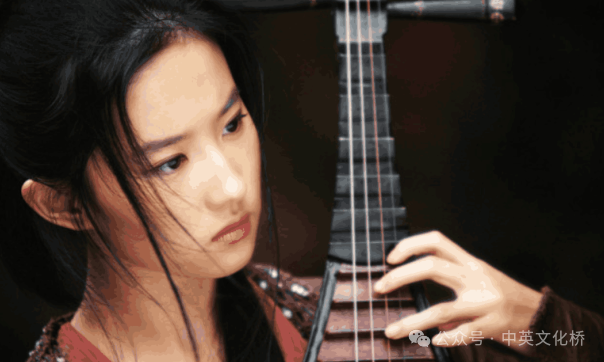Telling Chinese Culture in English: Traditional Instrument Pipa

The pipa is a traditional plucked string instrument in East Asia and has a history of more than 2,000 years in China. The instrument first known as the "pipa" emerged approximately during the Qin Dynasty.
琵琶,是东亚传统弹拨乐器,在中国已经有 2000 多年的历史,最早被称为“琵琶”的乐器大约在秦朝时期出现的。
The name "pipa" might come from "push the hand is pi, and pull the hand is ba" (the most basic plucking techniques) in "Shi Ming" by Liu Xi in the late Eastern Han Dynasty. So it was named "pi ba" (pipa). Before the Tang Dynasty, the pipa in Chinese referred to all plucked string instruments of the short-necked lute family (also known as the lute genus).
“琵琶”的名称可能来自东汉末年刘熙《释名》中“推手为批,引手为把”(最基本的弹拨技巧),所以名为“批把”(琵琶)。在唐朝以前,琵琶也是汉语里对所有短颈鲁特琴族(又称琉特属)弹拨乐器的总称。
The Chinese pipa spread to other regions in East Asia and developed into the Japanese pipa, the Korean pipa, the Vietnamese pipa, and the Ryukyu pipa.
中国琵琶传到东亚其他地区,发展成日本琵琶、朝鲜琵琶、越南琵琶和琉球琵琶。

The initial form of the pipa was different from the modern pipa. The main difference was that the ancient pipa was round, unlike the modern pear-shaped pipa. The pipa in the Qin and Han Dynasties belonged to the straight-neck pipa. The so-called "straight-neck" means that the handle of the instrument was straight. The body of the pipa in the Qin and Han Dynasties was disc-shaped. Ruan Xian, one of the Seven Sages of the Bamboo Grove in the Western Jin Dynasty, was good at playing the pipa. Therefore, this instrument was later called Ruan Xian.
最初的琵琶的形制跟现代琵琶不同,最主要的差别在于古代琵琶是圆形的,不同于现代梨形的琵琶。秦汉琵琶属于直项琵琶,所谓“直项”,是指乐器的琴柄毕直。秦汉琵琶琴身呈圆盘状,西晋时竹林七贤中的阮咸善于演奏琵琶,所以后世称这种乐器为阮咸。
In the ninth and tenth music divisions of the Sui and Tang Dynasties, the curved-neck pipa was the main instrument and played an important role in the development of the singing and dancing art in the prosperous Tang Dynasty. Du You of the Tang Dynasty wrote in "Tong Dian": "The sitting division is the Yan Music, mainly with the pipa, so it is called the pipa music."
在隋唐九、十部乐中,曲项琵琶是主要乐器,对盛唐歌舞艺术的发展起了重要作用。唐社佑《通典》云:“坐部伎即燕乐,以琵琶为主,故谓之琵琶曲。”

The ancient pipa once had four phases with 13 frets, 14 frets, 15 frets, etc. Now it has increased to six phases with 18 frets, 24 frets, 26 frets, 28 frets or 30 frets, arranged according to the 12-tone equal temperament. The six-phase 28-fret pipa has a range of A - g3. Commonly used techniques for the right hand include plucking, picking, pinch plucking, rolling, double plucking, double picking, dividing, hooking, wiping, grasping, buckling, brushing, sweeping, wheeling, half wheeling and other fingerings. For the left hand, there are techniques such as kneading, singing, bringing up, pressing, virtual pressing, twisting the string, overtones, pushing, pulling, broad, and injecting. Various harmonies and chords can be played. Famous pieces include "Ambush from Ten Sides", "Spring Snow", "Zhaojun Leaving the Frontier", etc.
古代琵琶曾有四相 13 品、14 品、15 品等,现已增加到六相 18 品、24 品、26 品、28 品或 30 品,按 12 平均律排列,六相二十八品的琵琶为音域 A-g3。常用技巧右手有弹、挑、夹弹、滚、双弹、双挑、分、勾、抹,摭、扣、拂、扫,轮、半轮等指法,左手有揉、吟、带起、捺打、虚按、绞弦、泛音、推、挽、绰、注等技巧。可演奏多种和音、和弦。著名乐曲有《十面埋伏》、《阳春白雪》、《昭君出塞》等。
